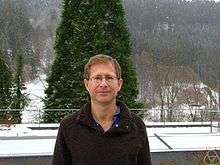Ehud Hrushovski

Ehud Hrushovski (Hebrew: אהוד הרושובסקי; born 1959) is a mathematical logician. He is a Merton Professor of Mathematical Logic at the University of Oxford and a Fellows Merton College, Oxford. He is also Professor of Mathematics at the Hebrew University of Jerusalem.
Early life and education
Hrushovski's father, Benjamin Harshav (Hebrew: בנימין הרשב, né Hruszowski; 1928-2015),[1] was a literary theorist, a Yiddish and Hebrew poet and a translator, Professor at Yale University and Tel Aviv University in comparative literature. Ehud Hrushovski earned his PhD from the University of California, Berkeley in 1986 under Leo Harrington. He was Professor of Mathematics at the Massachusetts Institute of Technology until 1998 before he went to Jerusalem.
Career
Hrushovski is well known for several fundamental contributions to model theory, in particular in the branch that has become known as geometric model theory, and its applications. His PhD thesis revolutionized stable model theory (a part of model theory arising from the stability theory introduced by Saharon Shelah). Shortly afterwards he found counterexamples to the Trichotomy Conjecture of Boris Zilber and his method of proof has become well known as Hrushovski constructions and found many other applications since.
One of his most famous results is his proof of the geometric Mordell–Lang conjecture in all characteristics using model theory in 1996. This deep proof was a landmark in logic and geometry. He has had many other famous and notable results in model theory and its applications to geometry, algebra, and combinatorics.
Hrushovski is a fellow of the American Academy of Arts and Sciences (2007), and Israel Academy of Sciences and Humanities (2008). He is a recipient of the Erdos Prize of the Israel Mathematical Union in 1994, the Rothschild Prize in 1998, the Carol Karp Prize of the Association of Symbolic Logic in 1993 (jointly with Alex Wilkie), and the Carol Karp Prize in 1998. He was a Plenary speaker of the ICM in 1998.
See also
References
- ↑ Archives, Ghetto Fighters' House